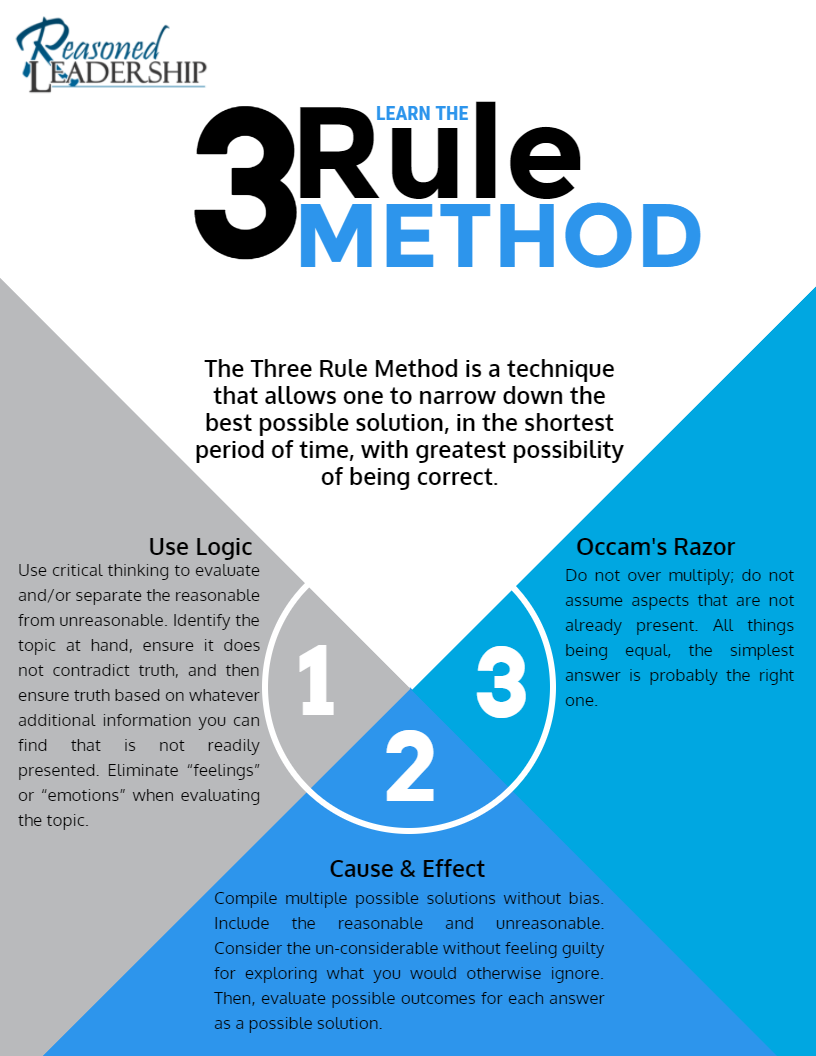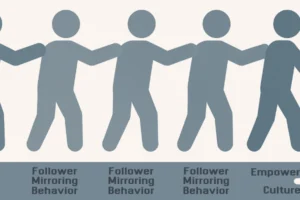The Three Rule Method: Decisions and Predictions
The Three Rule Method is a technique I developed during college that allowed me to narrow down the best possible solutions, in the shortest period of time, with the greatest possibility of being correct. It’s called the Three Rule Method because it comprises three very basic rules, but placed in a specific order, like an equation. Using the Three Rule Method correctly must be a systematic process with each step being consciously observed and worked.
As it turned out, with a little bit of practice, it was functional in many other areas besides just taking tests. I began to practice the method in almost all areas of life and found that, more often than not, it was extremely effective and highly accurate. I must stress, however, that it takes practice and discipline because if you lie to yourself, the model cannot work.

To demonstrate this model, we will use the following statement:
“Thomas is a great guy, he throws the best parties. Come to Tom’s house with me tonight!”
Now, we apply the model which appears as follows: Basic Logic > Cause and Effect > and Occam’s Razor.
Basic Logic: Use your best critical thinking skills to evaluate and/or separate truth from falsehood or reasonable from unreasonable beliefs. You need to identify the topic at hand, ensure it does not contradict truth, and finally, ensure truth based on whatever additional information you can find that is not readily presented. This could include your own personal memory or any other clues you might be able to find. In this step, it is usually best to eliminate “feelings” or “emotions” when evaluating the topic.
Example:
Basic logic tells us only that Thomas is a male, he is known for throwing parties, and the person asking the question is obviously going tonight. We do not know if Thomas is really a great guy or a serial killer. We do not know if the only reason he is considered a great guy is that he throws great parties or buys everyone drinks. These other pieces of information are really just opinions. What if you do not like parties? What if you do not like to drink? What if the parties really are not that great?
Cause and Effect: A cause is WHY something happens. An effect is WHAT happens due to that cause. In this phase, compile multiple possible solutions without bias. From the reasonable to the unreasonable. This step is vital because it allows you to consider the un-considerable without feeling guilty for exploring what you would otherwise ignore. Then, you evaluate possible outcomes for each answer as a possible solution.
Example Cont:
- Option 1 – Thomas is, in fact, a serial killer. If I go tonight, I will die a horrible death after he executes a drug-facilitated sexual assault on me, having spiked my drink with Rohypnol.
- Option 2 – I will go to the party, meet someone special, and spend the rest of my life in bliss. I have to go because if I do not, I will miss out on the best years of my life.
- Option 3 – Thomas is really only considered a nice guy because he buys everyone drinks. He is really just a lonely guy with few real friends. He is probably a pompous Ass, but if I avoid him, I may have a good time, and the drinks will be free anyway.
- Option 4 – My friend is going to the party, so Thomas cannot be too bad. And if something does start to get out of hand, I have my friend there to help keep an eye on things. And who knows, I might meet some new friends.
- Option 5 – My friend is always right about everything. Thomas is a great guy, and I should do exactly what my friend says.
Occam’s Razor (or Ockham’s razor): This is an old philosophy that states that among competing hypotheses, the hypothesis with the fewest assumptions should be selected. In other words, do not over-multiply; do not assume aspects that are not already present. All things being equal, the simplest answer is probably the right one.
Example Cont:
So now that you have some options, you get to decide. Once again, while evaluating your possibilities, you use logic, not emotional bias like fear. Occam’s Razor aids in the selection. In the example provided, Thomas is probably not a serial killer. Your friend seems to like him, and you like your friend. Thomas may actually be a jerk, but your friend will be there with you. No one is perfect, but you might actually enjoy yourself. So, the best option is probably going to be Option 4.
Understand that what you have done is used your brain to effectively make a prediction several hours in the future. Granted, many people make decisions like this every day without giving it this much thought. So imagine what you could do if you did make an effort and practiced the steps.
I have used the Three Rule Method effectively throughout the years for a number of different things. As I practiced it more and more, I began to realize that instead of just projecting hours or even one day, one could project months and sometimes even years if provided enough evidence to consider.
NOTE: The Three Rule Method cannot account for alterations in the decisions of others. It should be noted that when dealing with projections, it is a “best-educated guess” based on the information currently available. I would also recommend quarterly reevaluations of the information in the model to ensure the integrity of the projection if you are doing long-term models.
In order to look longer term, you need to add in a few steps. The model then appears as follows:
Basic Logic > Cause and Effect > Occam’s Razor > Cause and Effect > Basic Logic > Occam’s Razor
In other words, take your first conclusion and apply cause and effect to get even more solutions, reapply basic logic, and choose the best answer out of the new options.
Have fun, but use the Three Rule Method responsibly.




